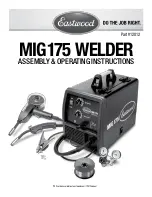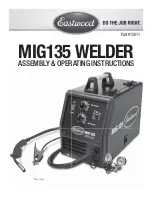
V4.0
200A Multi-Process Welder with LCD Display
8785115
Visit www.princessauto.com for more information
13
3. Do not deface or alter the name, number or other markings on a cylinder. Do not
rely on a cylinder’s colour to identify the contents. Do not connect a regulator to
a cylinder that contains a gas that the regulator was not designed to handle.
4. Do not expose a cylinder to excessive heat, sparks, slag, flame or any other
heat source.
a. A cylinder exposed to temperatures above 130 °F will require water
spray cooling. This method may not be compatible with electric
welding units due to the hazard of electrocution.
5. Do not expose a cylinder to electricity of any kind.
6. Do not attempt to lubricate a regulator. Always change a cylinder carefully
to prevent leaks and damage to the cylinder’s walls, valve or safety
devices.
7. Gases in the cylinder are under pressure. Protect the cylinder from bumps,
falls, falling objects and harsh weather. A punctured cylinder under
pressure can become a lethal projectile. If a cylinder is punctured, do not
approach until all pressure is released.
a. Protect the valve and regulator. Damage to either can result in
regulator’s explosive ejection from the cylinder.
8. Always secure a gas cylinder in a vertical position to a welding cart or
other fixed support with a steel chain, so it cannot be knocked over.
a. Away from areas where they may be struck or subjected to physical
damage.
b. A safe distance from arc welding or cutting operations and any other
source of heat, sparks or flame.
b. Do not use as an improvised support or roller.
9. Always place the cylinder cap securely on the cylinder unless it is in use or
being serviced.
10. Do not use a wrench or hammer to open a cylinder valve that cannot be
opened by hand. Notify your supplier for instructions.
11. Do not modify or exchange gas cylinder fittings.
12. Close the cylinder valve and immediately remove the faulty regulator from
service for repair, if any of the following conditions exist:














































